30 March, 2000
Changing Seasons
Question 40: If the Antarctic Treaty was signed in 1959, what do the Treaty
nations still need to vote on?
Although today the beautiful sunny weather came back to us, the air
temperature is well below freezing. We can see our breath, and it is the
first day that we have seen any sign of pancaking ice on the ocean. Up until
now, all the ice floating in the water was glacial in origin. Today there is
a frozen margin of sea water around the pieces of brash ice. Some of the
smaller pieces have been conglomerated into large groupings. Because of the
action of moving water, all the pieces are crunching together and creating
rounded shapes .
March is the month with the least surface ice coverage in Antarctica. The
flip side of that statement is that the pack ice starts forming again in
April. This far south, summer and winter temperatures are not that far apart;
yearly sea water temperatures range from +1.8 to -1.8 C. Once the surface
layer of water gets supercooled and below the freezing point, ice starts to
form. The first stage consists of small plate crystals and needles called
frazil ice. Continued freezing creates grease ice, a slushy mixture of
frazil crystals that haven't yet started to attach to one another. Once more
than 35% of the surface is ice crystals, the change to a solid cover of ice
begins as the ice consolidates into floes. When there are waves, this change
creates pancakes, rounded aggregates of semi-consolidated slush from 30 cm to
3 meters in diameter. Eventually these come together to form an ice sheet.
The pancakes we see today may not last or they might be the start of winter.
Similarly, at this time of year, you never know which snowfall will be the one
that stays.
On the shadowed side of the islands, frost created on the rocks by the surf
spray is visible. It further reminds me that it is fall, a season of great
variation in conditions. Prevailing wind direction can shift hourly, water
and air temperatures bob back and forth between summer and winter, and the
light keeps waning away. When we first arrived here at the start of March we
had 14 hours of daylight. We are now down to 11 hours. When we leave in May,
there will be only 7.5 hours of daylight, still not the lowest the station
has which is 3.5 hours at winter solstice on June 21. For those in Alaska,
the seasonal light cycle is similar to what would be experienced at Cantwell.
At the same time we are noticing the signs of winter coming, the other
inhabitants have seen the same signs and acted. We haven't seen a fur seal
for two days; they have moved on. In fact, the occasional Leopard and Weddell
seals have been our only recent sightings of pinipeds. The bird community is
also changing. There are fewer skuas around. The ones that are still here
are grouping together, as are the terns. The first Snowy Sheathbill returned
to Palmer Station yesterday. When it is skua breeding season here, they
outnumber and hound the sheathbills. Since the sheathbills can't compete with
skuas, they disperse during breeding season and return only when the skuas
start to leave. Sheathbills are scavengers that move like a cross between a
chicken and a pigeon. They spend the winter at Palmer.
Answer 39: The Antarctic Treaty is an agreement negotiated in 1959 by a group
of nations. It suspended territorial claims, guaranteed freedom for
scientific research, and made the entire continent and surrounding ocean a
military and nuclear free zone. Its international government system is still
operating actively. There are now 26 countries with voting rights (most are
ones actively doing scientific work on the continent) and another 17 which
support the treaty but do not have voting rights.
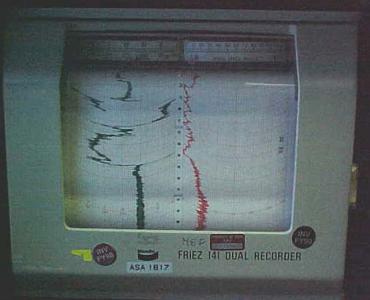
Our record of wind direction (left drum) and speed (ranging from under 10 to 30 knots).
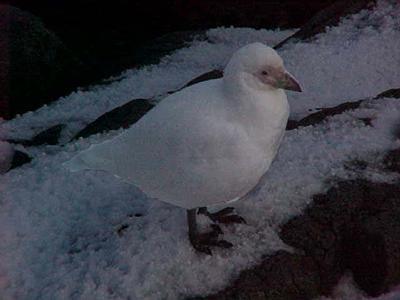
Snowy Sheathbill
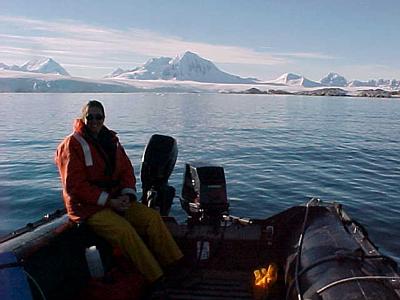
Enjoying the weather while dive tending at Christine Island. Anvers Island is in the background with Mts. Moberly, William and Hindson (l to r).
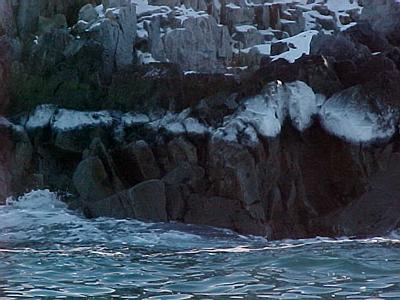
Frost on the shore of Shortcut Island.
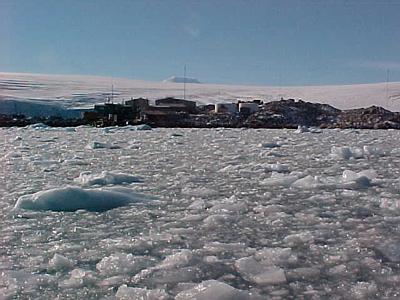
Thick brash ice around Palmer Station. Notice the large angular shapes projecting above the water. It is from the glacier.
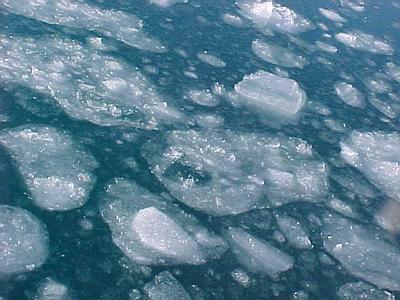
Pancake ice forming. All less than 1 meter in diameter.

Contact the TEA in the field at
.
If you cannot connect through your browser, copy the
TEA's e-mail address in the "To:" line of
your favorite e-mail package.
|
